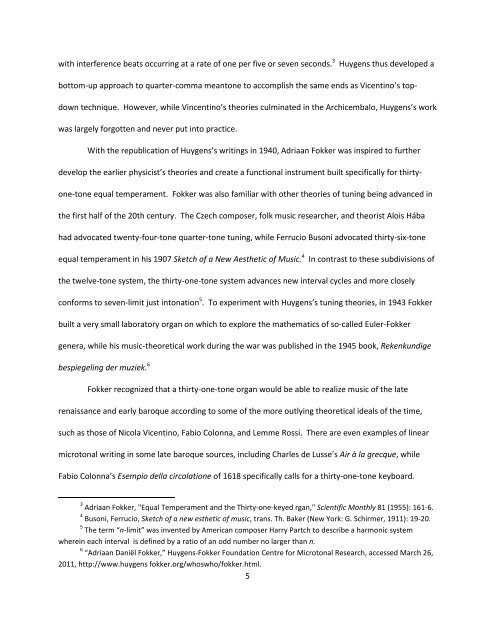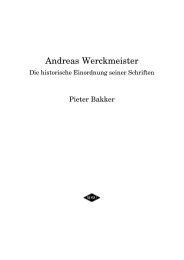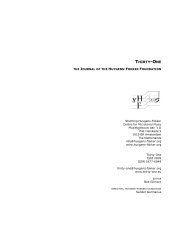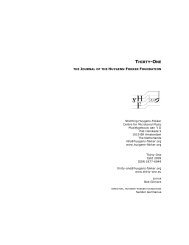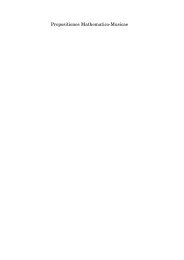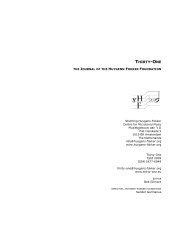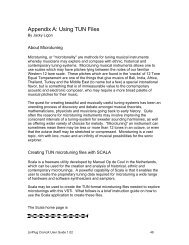Recent Organ Design Innovations and the 21st-century - Stichting ...
Recent Organ Design Innovations and the 21st-century - Stichting ...
Recent Organ Design Innovations and the 21st-century - Stichting ...
Create successful ePaper yourself
Turn your PDF publications into a flip-book with our unique Google optimized e-Paper software.
with interference beats occurring at a rate of one per five or seven seconds. 3 Huygens thus developed a<br />
bottom-up approach to quarter-comma meantone to accomplish <strong>the</strong> same ends as Vicentino’s top-<br />
down technique. However, while Vincentino’s <strong>the</strong>ories culminated in <strong>the</strong> Archicembalo, Huygens’s work<br />
was largely forgotten <strong>and</strong> never put into practice.<br />
With <strong>the</strong> republication of Huygens’s writings in 1940, Adriaan Fokker was inspired to fur<strong>the</strong>r<br />
develop <strong>the</strong> earlier physicist’s <strong>the</strong>ories <strong>and</strong> create a functional instrument built specifically for thirty-<br />
one-tone equal temperament. Fokker was also familiar with o<strong>the</strong>r <strong>the</strong>ories of tuning being advanced in<br />
<strong>the</strong> first half of <strong>the</strong> 20th <strong>century</strong>. The Czech composer, folk music researcher, <strong>and</strong> <strong>the</strong>orist Alois Hába<br />
had advocated twenty-four-tone quarter-tone tuning, while Ferrucio Busoni advocated thirty-six-tone<br />
equal temperament in his 1907 Sketch of a New Aes<strong>the</strong>tic of Music. 4 In contrast to <strong>the</strong>se subdivisions of<br />
<strong>the</strong> twelve-tone system, <strong>the</strong> thirty-one-tone system advances new interval cycles <strong>and</strong> more closely<br />
conforms to seven-limit just intonation 5 . To experiment with Huygens’s tuning <strong>the</strong>ories, in 1943 Fokker<br />
built a very small laboratory organ on which to explore <strong>the</strong> ma<strong>the</strong>matics of so-called Euler-Fokker<br />
genera, while his music-<strong>the</strong>oretical work during <strong>the</strong> war was published in <strong>the</strong> 1945 book, Rekenkundige<br />
bespiegeling der muziek. 6<br />
Fokker recognized that a thirty-one-tone organ would be able to realize music of <strong>the</strong> late<br />
renaissance <strong>and</strong> early baroque according to some of <strong>the</strong> more outlying <strong>the</strong>oretical ideals of <strong>the</strong> time,<br />
such as those of Nicola Vicentino, Fabio Colonna, <strong>and</strong> Lemme Rossi. There are even examples of linear<br />
microtonal writing in some late baroque sources, including Charles de Lusse’s Air à la grecque, while<br />
Fabio Colonna’s Esempio della circolatione of 1618 specifically calls for a thirty-one-tone keyboard.<br />
3<br />
Adriaan Fokker, "Equal Temperament <strong>and</strong> <strong>the</strong> Thirty-one-keyed rgan," Scientific Monthly 81 (1955): 161-6.<br />
4<br />
Busoni, Ferrucio, Sketch of a new es<strong>the</strong>tic of music, trans. Th. Baker (New York: G. Schirmer, 1911): 19-20.<br />
5<br />
The term “n-limit” was invented by American composer Harry Partch to describe a harmonic system<br />
wherein each interval is defined by a ratio of an odd number no larger than n.<br />
6<br />
“Adriaan Daniël Fokker,” Huygens-Fokker Foundation Centre for Microtonal Research, accessed March 26,<br />
2011, http://www.huygens fokker.org/whoswho/fokker.html.<br />
5


